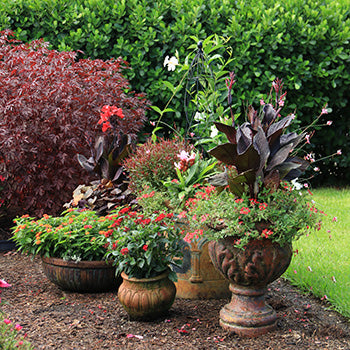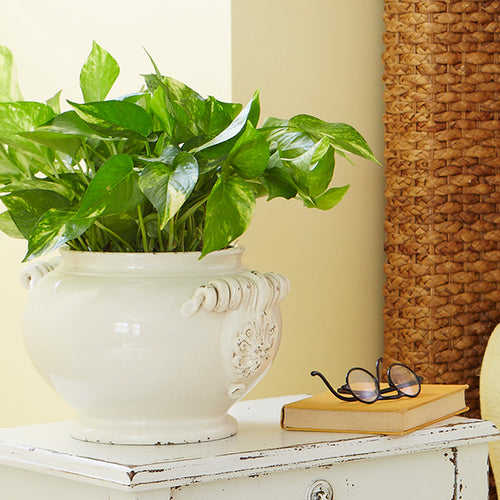By Doug Jimerson
Water-wise plant practically thrive on neglect. The plants below are perfect for the forgetful
gardener, traveler, or the person looking for beautiful plants without any fuss.

Agave
Agaves always make a bold statement, whether they are planted in
the ground or in containers. Their stiff, sword-like leaves form a rosette in green or blue or striped with white or
yellow. Because they are desert natives, agaves need little care to thrive. Their only requirements are lots of sun and
well-drained soil. In the north, grow agaves in containers and move them indoors when nightly temperatures dip below 50
degrees F. They’ll be happy in a sunny window until spring. Just be sure not to overwater them, especially during the
winter when their moisture requirements are low. Agave ferox (in photo) is a common variety and is hardy
outdoors from Zones 6-11.

Aloe
Chances are, you’re familiar with the common Aloe
vera plant and its healing properties. But there are a host of other aloe varieties that make excellent
landscape or indoor plants. Some of our favorites include Aloe Cha-Cha, (in photo) which has dark
green leaves splotched with cream, Aloe ‘Dorian Black’ which forms a tight clump of pale green leaves with
raised white ridges, and Aloe brevifolia with its pale green rosette foliage and soft white spines. Other
easy-care aloes are Aloe ciliaris, Aloe juvenna, and Aloe aristata. These aloes look terrific planted
together or singly in a dish garden or garden bed. If you are growing aloes in the north, they need to be brought inside
once the temperatures drop below 50 degrees F. Outdoors they are hardy from Zones 6-11.

Crassula
Commonly called jade plant, Crassula
ovata (in photo), is an extremely easy-to-grow plant with pretty, spoon-shaped fleshy leaves on thick
greenish-gray stems. A South African native, jade plant is naturally tolerant of hot, dry conditions. It makes an
excellent landscape plant in frost-free regions and works well as a container plant indoors or out. Mature jade plants
also produce clusters of small pink or white blooms in the early spring that add to the plant’s appeal. Because it is
frost sensitive, jade plants should be moved indoors when temperatures drop below 55 degrees F. Keep the plant in a
bright location and cut back on watering during the winter months. Outdoors they are hardy in Zones 10-11.

Echeveria
Perfect for dish gardens or small pots, echeverias
produce handsome blue, green, or silver leaves that grow in tight rosettes, forming a living boutonniere of foliage.
Echeverias also develop new plants around their base that can be broken off and planted in other locations. Some choice
varieties of echeveria include Topsy Turvy with its interesting crimped leaves and Liliciana that has pretty silver
foliage packed like rose petals around its center. Other great echeveria selections for your garden include Elegans
(in photo) and Peacockii. All echeverias require a sunny spot, indoors or out. Outdoors they are hardy from
Zones 6-11.

Euphorbia
Choose euphorbias for drama and architectural interest. These upright
beauties have tall lobed stems, often bearing small leaves or spines. They are also almost impossible to kill; as long
as they have enough light they can survive on little water or food. Euphorbias are ideal for the frequent traveler or
those who forget to water. Young euphorbias also look great in dish gardens or small planters. One top pick is
Euphrobia trigona ‘Good Luck’ which is topped with small shiny green leaves. Its stems are also delicately
etched in pale green. For even more drama, go with one of two euphorbias with contorted stems. Both Euphorbia lactea
compacta (in photo) and Euphorbia tortilis have twisted stems and sharp spines. Grown outdoors,
euphorbias are hardy from Zones 6-11.

Haworthia
e garden or the house, but otherwise, it’s tough as nails.
Over time, haworthias develop young plants around their base that can be removed and planted elsewhere. Our favorite
selection is Haworthia fasciata (in photo) that stays compact, rarely growing over 8 inches tall. Outdoors
haworthia is hardy from Zones 9-11.

Kalanchoe
Kalanchoes
are a diverse group of charming little plants that offer a variety of leaf forms. For example Kalanchoe
thyrsiflora (in photo), also called paddle plant or flapjacks, forms a cluster of round, fleshy, pale green
leaves with red edges. Yet, Kalanchoe tomentosa ‘Chocolate Soldier’, which is often called panda plant, has
long oval leaves covered in brown fur. And Kalanchoe x beharensis goes by the common name of elephant ears or
feltbush because of its large, gray velvety foliage. Although they all look very different, they all require bright
light and little water to stay healthy. Outdoors they are hardy from Zones 10-11.

Mamillaria
What’s cuter than mamillaria cactus? A layer of star-like thorn clusters
covers these short, round plants; each year, these chubby cacti also develop a crown of purple flowers followed by
slender red fruits. They are extremely easy care! One of our favorite varieties, Mammillaria guelzowiana (in
photo), grows about 7 inches tall and has attractive, slightly twisted spines and trumpet-shape purple
blooms.

Opuntia
Also known as paddle cactus or prickly pear, opuntia is an easy-care plant that
thrives in any sunny spot, indoors or out. Although some varieties of opuntia have long, sharp thorns, our two favorites
have clusters of short white spines against a dark green background. Opuntia microdasys ‘Albata’, commonly
called bunny ears, can grow 3 to 6 feet tall; young specimens grow slowly and can easily fit into a mixed succulent
container. In the spring, mature plants develop yellow blooms followed by red fruits. Optunia microdasys rufida (in
photo), often called cinnamon cactus, looks a lot like Albata, but the small clusters of spines are reddish in
color. Both are hardy outdoors from Zones 9-11.

Senecio
If you’re looking for a pretty, easy care succulent to plant in a mixed container, consider Senecio
ficoides (in photo). Its smooth, gray-green leaves provide a refreshing contrast to other succulents and cacti.
Senecio also makes an interesting ground cover in zones 9-11 where it is winter hardy. In other regions, senecio works
well as an indoor houseplant. It grows 6 to 12 inches tall.
















